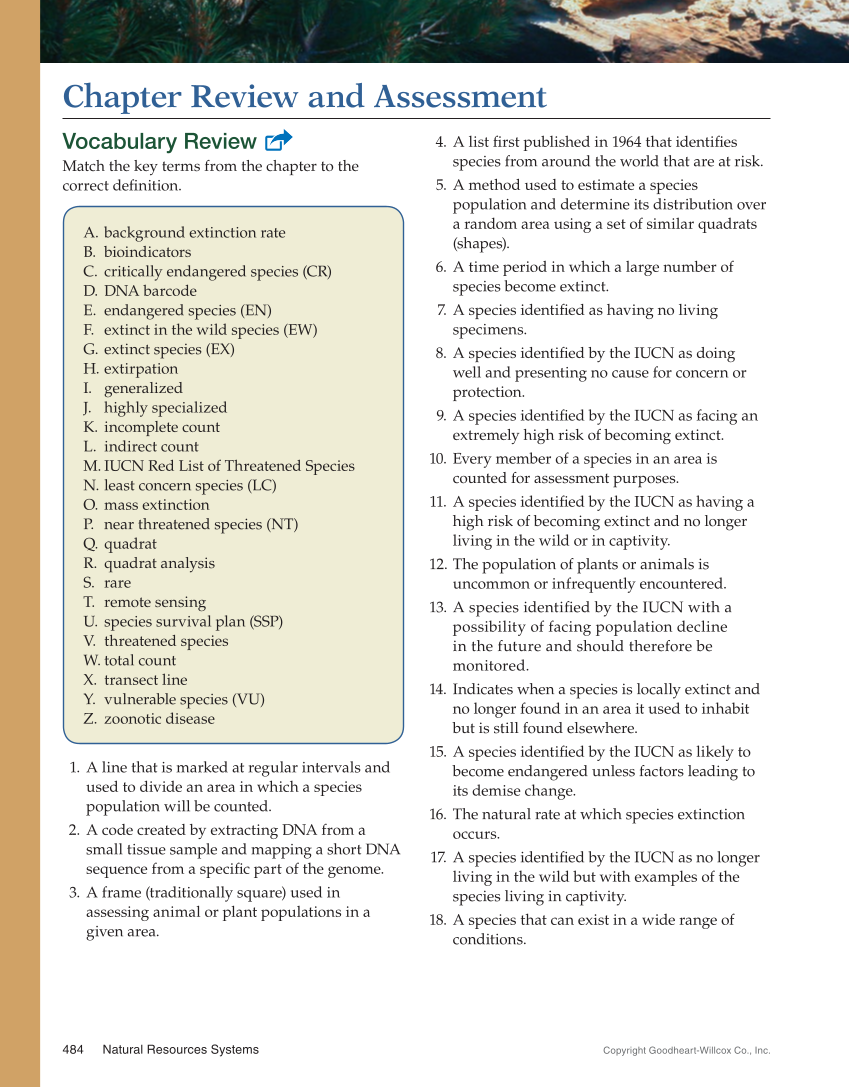484 Natural Resources Systems Copyright Goodheart-Willcox Co., Inc. Chapter Review and Assessment Vocabulary Review Match the key terms from the chapter to the correct defi nition. A. background extinction rate B. bioindicators C. critically endangered species (CR) D. DNA barcode E. endangered species (EN) F. extinct in the wild species (EW) G. extinct species (EX) H. extirpation I. generalized J. highly specialized K. incomplete count L. indirect count M. IUCN Red List of Threatened Species N. least concern species (LC) O. mass extinction P. near threatened species (NT) Q. quadrat R. quadrat analysis S. rare T. remote sensing U. species survival plan (SSP) V. threatened species W. total count X. transect line Y. vulnerable species (VU) Z. zoonotic disease 1. A line that is marked at regular intervals and used to divide an area in which a species population will be counted. 2. A code created by extracting DNA from a small tissue sample and mapping a short DNA sequence from a specifi c part of the genome. 3. A frame (traditionally square) used in assessing animal or plant populations in a given area. 4. A list fi rst published in 1964 that identifi es species from around the world that are at risk. 5. A method used to estimate a species population and determine its distribution over a random area using a set of similar quadrats (shapes). 6. A time period in which a large number of species become extinct. 7. A species identifi ed as having no living specimens. 8. A species identifi ed by the IUCN as doing well and presenting no cause for concern or protection. 9. A species identifi ed by the IUCN as facing an extremely high risk of becoming extinct. 10. Every member of a species in an area is counted for assessment purposes. 11. A species identifi ed by the IUCN as having a high risk of becoming extinct and no longer living in the wild or in captivity. 12. The population of plants or animals is uncommon or infrequently encountered. 13. A species identifi ed by the IUCN with a possibility of facing population decline in the future and should therefore be monitored. 14. Indicates when a species is locally extinct and no longer found in an area it used to inhabit but is still found elsewhere. 15. A species identifi ed by the IUCN as likely to become endangered unless factors leading to its demise change. 16. The natural rate at which species extinction occurs. 17. A species identifi ed by the IUCN as no longer living in the wild but with examples of the species living in captivity. 18. A species that can exist in a wide range of conditions.
